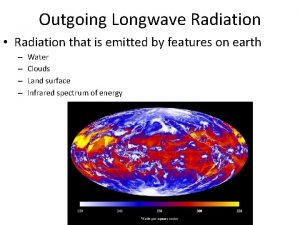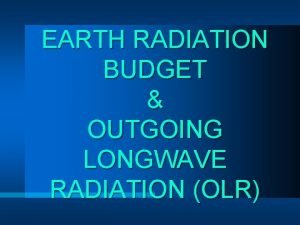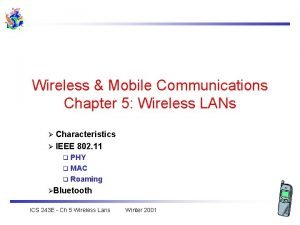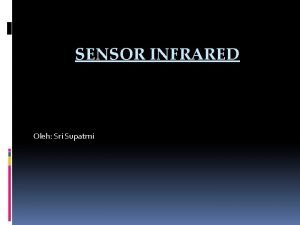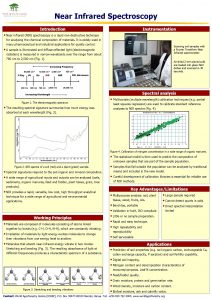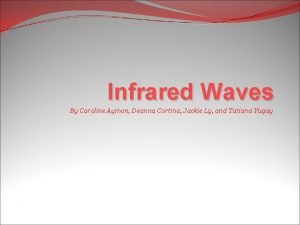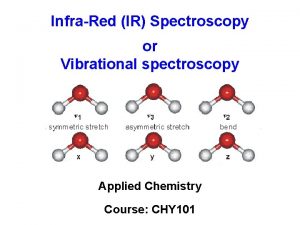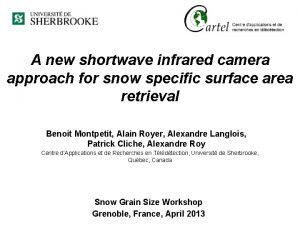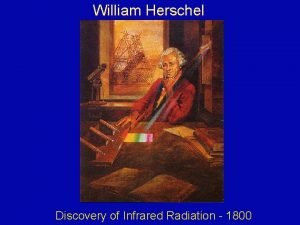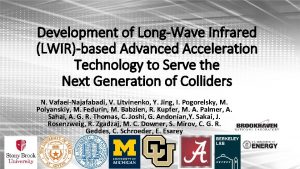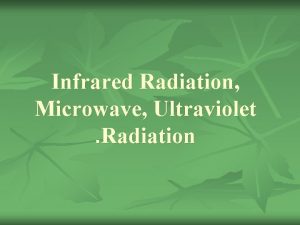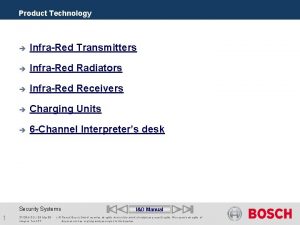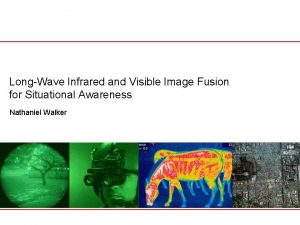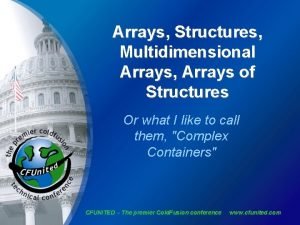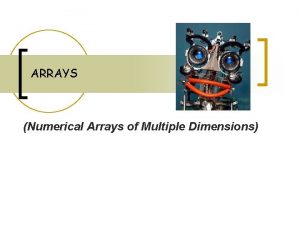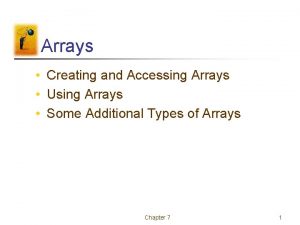Development of Sensitive Longwave Infrared Detector Arrays for















- Slides: 15

Development of Sensitive Long-wave Infrared Detector Arrays for Passively Cooled Space Missions Craig Mc. Murtry, Donald Lee, James Beletic, Chi-Yi A. Chen, Richard T. Demers, Meghan Dorn, Dennis Edwall, Candice Bacon Fazar, William J. Forrest, Fengchuan Liu, A. Mainzer, Judith L. Pipher, Aristo Yulius

• We wanted to develop LWIR (10 micron) Hg. Cd. Te detector arrays for many years. LWIR Hg. Cd. Te is an alternative to Si: As arrays for space missions that do not require wavelength coverage to 27 microns. LWIR Hg. Cd. Te can be operated at 35 – 40 K which allows for longer lasting and less expensive passively cooled space missions. For example, the Spitzer Space Telescope has exhausted its cryogens but continues to take data in a reduced capacity. The IRAC instrument had 4 IR broadband imaging sensors, all of which operated with wavelengths less than 10 microns. The focal plane of the IRAC instrument is now at T=27. 8 K, but only the two In. Sb arrays are working while the two Si: As arrays are not.

e c t • Where did we get funding for this LWIR Hg. Cd. Te detector development? C • Discovery proposal submitted in 2006, 2010 a • Awarded technology development in 2010 m • Wide-field imager operating at 2 wavelengths: 4 -5 & 6 -10 mm e r • 4+ year mission to discover & characterize near-Earth objects (NEOs), a Main Belt asteroids, comets ( N

c t • NEOCam's primary science objectives are C threefold: • To assess the present-day risk of near-Earth a object (NEO) impact. m • To study the origin and ultimate fate of our solar system's asteroids. e • To find the most suitable NEO targets for future exploration by robots and humans. r a ( N

e c t – Why do we need LWIR arrays? Why can’t Pan. C STARRS and LSST find all the NEOs? • Sorry CCD folks, but asteroids below 1 Km are a difficult to detect at visible wavelengths. – Small surface area m – Low surface reflectivity (albedo) – Can’t see interior to earth due to sunlight e • But for objects that around 1 AU (Earth-Sun r distance), their temperature is about 300 K. – Blackbody peak at 10 microns! a ( N

LWIR Hg. Cd. Te Detector Characterization NEOCam Requirements: All of the results presented here are for SCA H 1 RG-16885. 1024 x 1024 pixels 10. 6 micron cutoff at T=30 K. Requirement Format 1024 x 1024 Wavelength 10 mm Temperature 35 – 40 K Dark Current <200 e-/s/pix CDS Read <50 e. Noise QE >60% (not AR coated) Well depth >45 Ke. Operability >90%

LWIR Hg. Cd. Te Detector Characterization Well Depth vs. Dark Current Having low dark current but low well depth is not useful. This shows that most of the pixels have excellent well depth with very low dark current, and are centered around 0. 1 e-/s and 230 m. V. 180 m. V = 50 Ke- 230 m. V = 63 Ke-

LWIR Hg. Cd. Te Detector Characterization Histogram of cumulative dark current 200 m. V applied reverse bias. T = 35 K

LWIR Hg. Cd. Te Detector Characterization Histogram of Read Noise Fowler-1 or CDS.

LWIR Hg. Cd. Te Detector Characterization Operability vs. Temperature 200 m. V applied reverse bias. All pixels that have <200 e-/s dark current with > 180 m. V of well depth and < 50 eread noise are classified as operable.

LWIR Hg. Cd. Te Detector Characterization Dark Current vs. Temperature 200 m. V applied reverse bias. All plotted have 240 m. V ACTUAL well depth. Dark current at low end is limited by light leak (from 77 K shield through 4 K shield). Wow, at 35 K we are achieving 1000 times lower dark current than our requirement!

LWIR Hg. Cd. Te Detector Characterization

Hg. Cd. Te Detector Development 4 goals for NEOCam detector development: Increase cutoff wavelength to >10 mm: DONE Increase % pixels meeting dark current spec to >=90%: DONE Increase operability (well depth): DONE Increase format from 512 x 512 to 1024 x 1024 pixels: DONE

Hg. Cd. Te Detector Development We have gone past the original directives for this program. Achieved substrate removal. Started radiation hardness testing (high energy protons).

Conclusions The 10. 6 micron cutoff Hg. Cd. Te developed by TIS is performing well at temperatures between 35 – 40 K. LWIR Hg. Cd. Te is now ready for sensitive (astronomical) space missions that would benefit from the cost savings of eliminating cryogens or cryo-coolers. Future work: Complete proton radiation testing (TRL-6!!) Extend cutoff wavelength to 15 microns (funded!)
 Outgoing longwave radiation
Outgoing longwave radiation Olrearth
Olrearth Infrared vs bluetooth
Infrared vs bluetooth Infrared vs bluetooth
Infrared vs bluetooth Pengertian sensor infrared
Pengertian sensor infrared Nir spectroscopy instrumentation
Nir spectroscopy instrumentation Bill nye light and optics
Bill nye light and optics Tatiana yugay
Tatiana yugay Infrared spektroskopisi
Infrared spektroskopisi Nitro group ir
Nitro group ir Signage posted at a handwashing station must include
Signage posted at a handwashing station must include Shortwave infrared camera
Shortwave infrared camera Bluetooth vs infrared
Bluetooth vs infrared Kuas hybridboard
Kuas hybridboard Herschel infrared discovery
Herschel infrared discovery Infrared spectroscopy theory
Infrared spectroscopy theory
